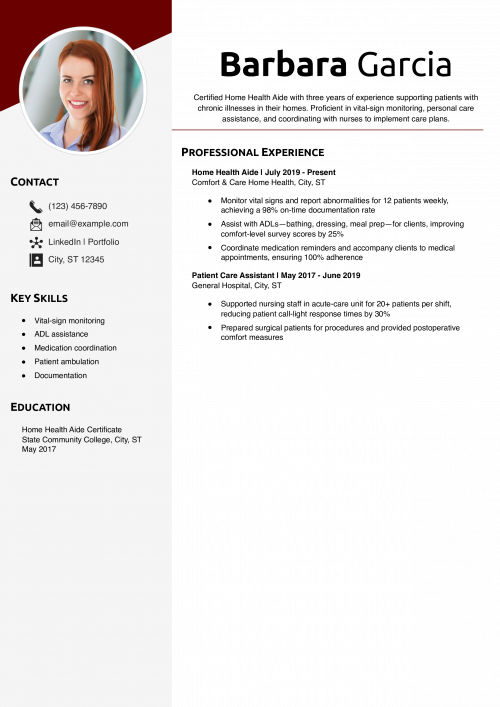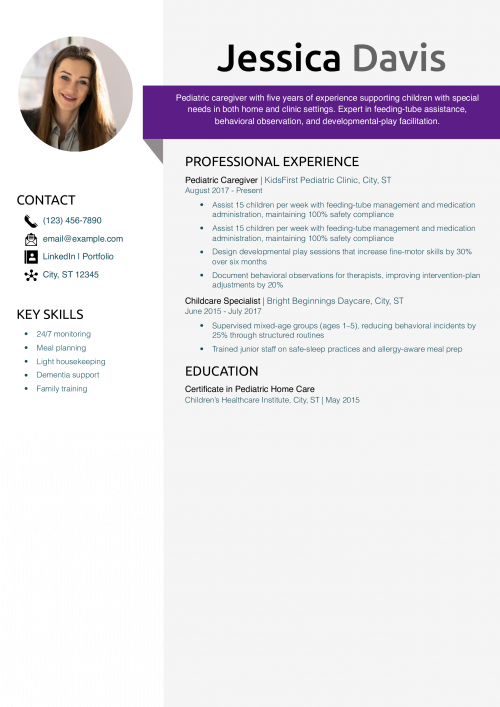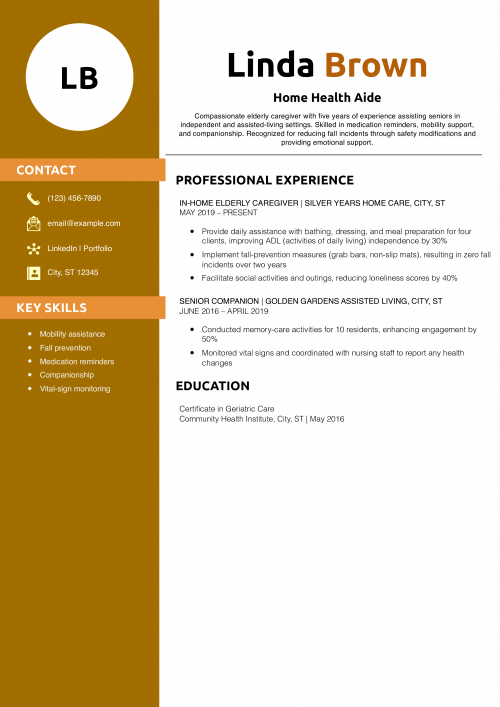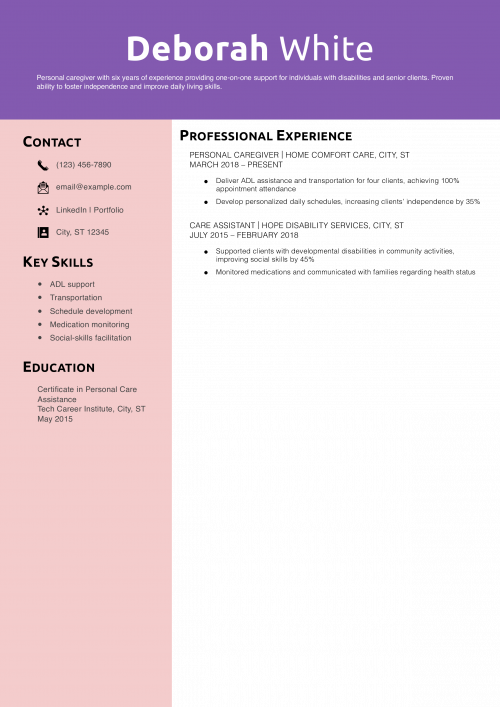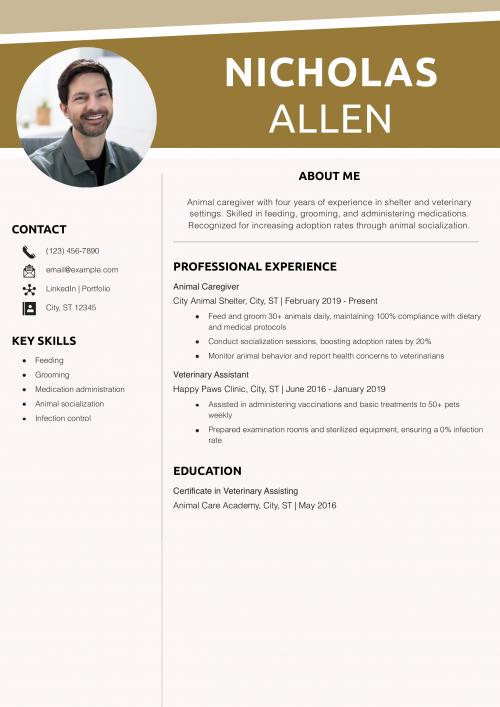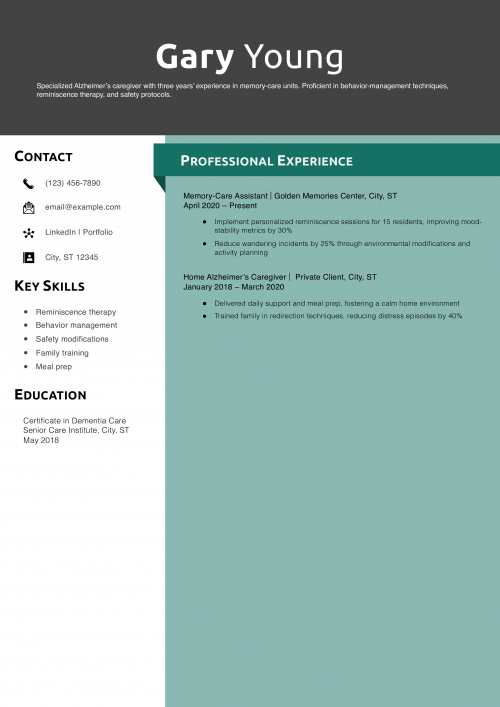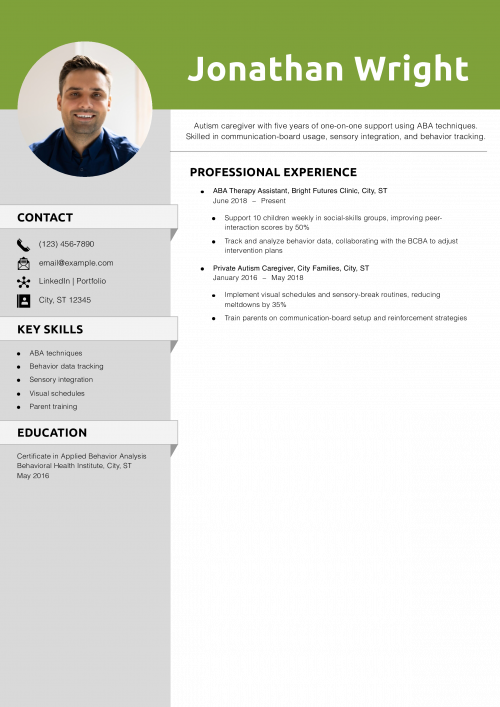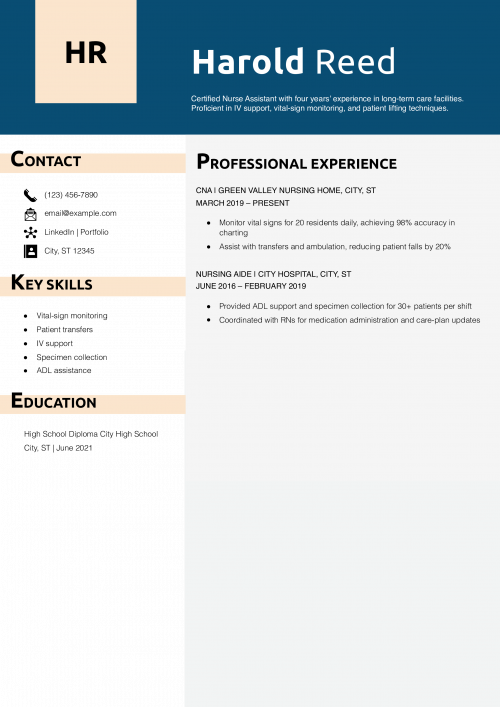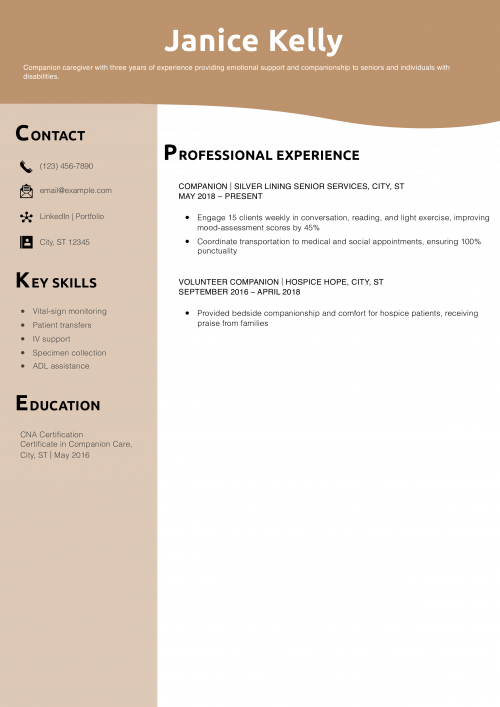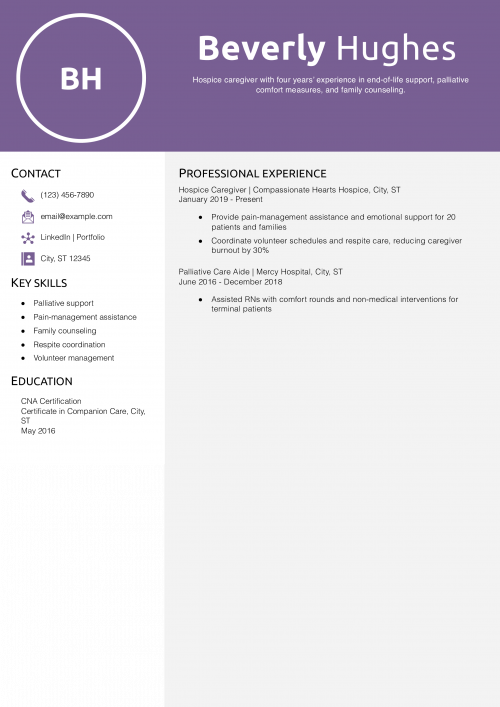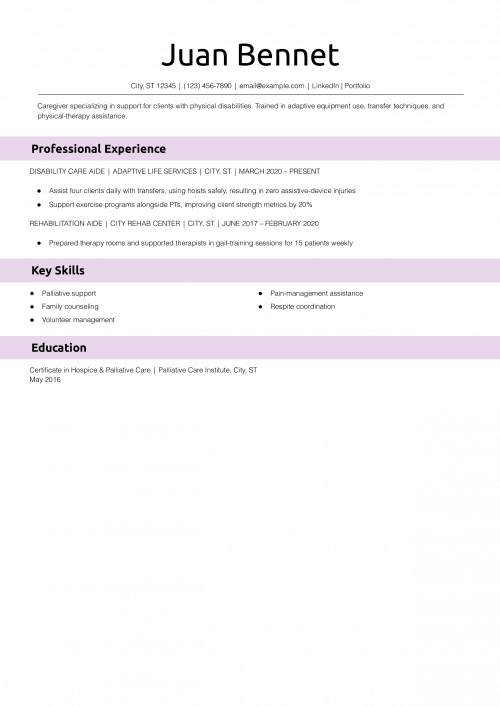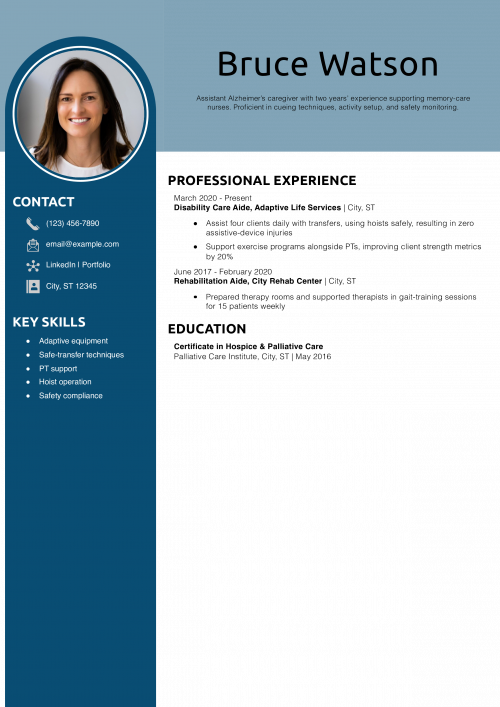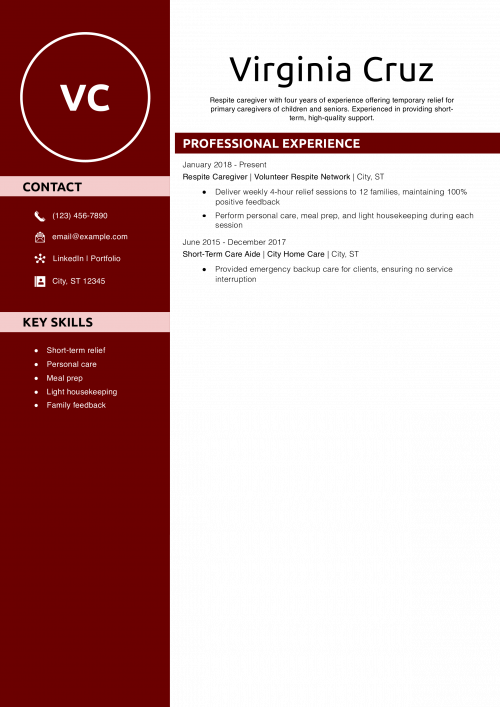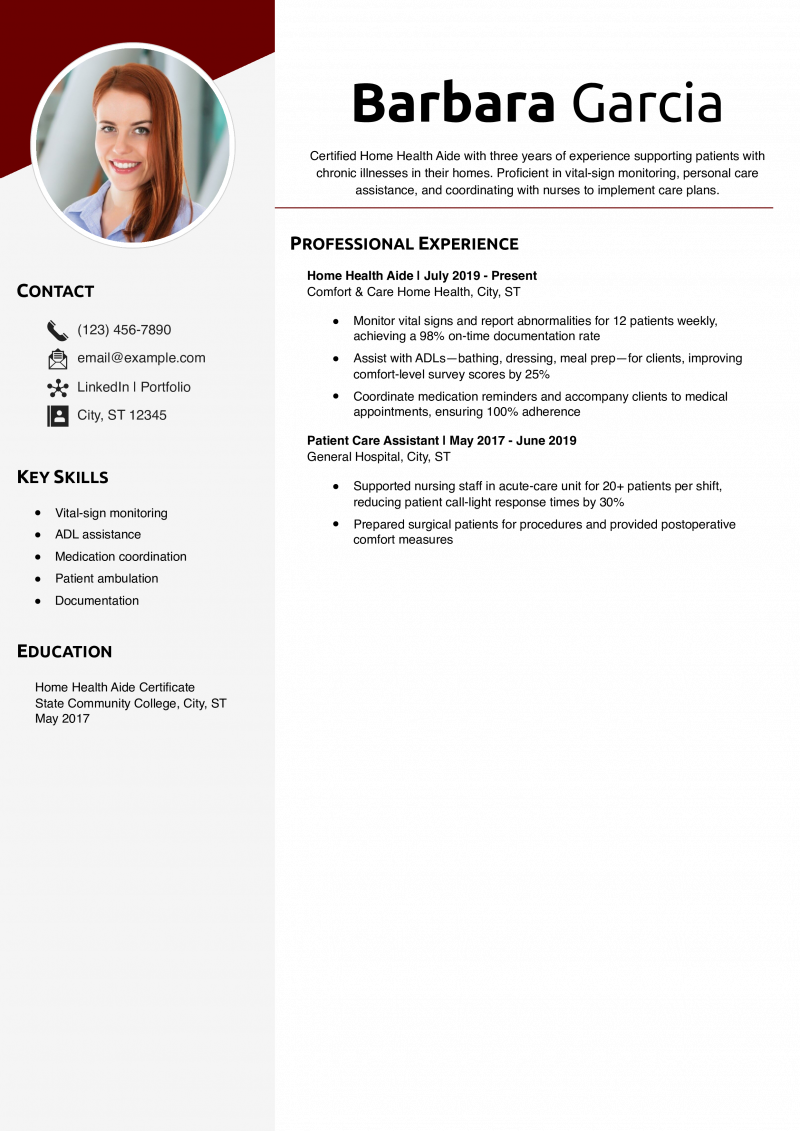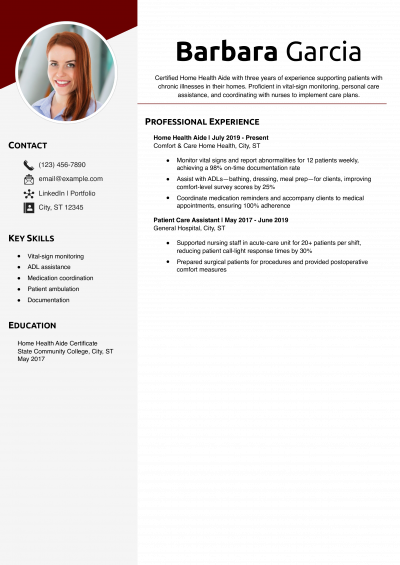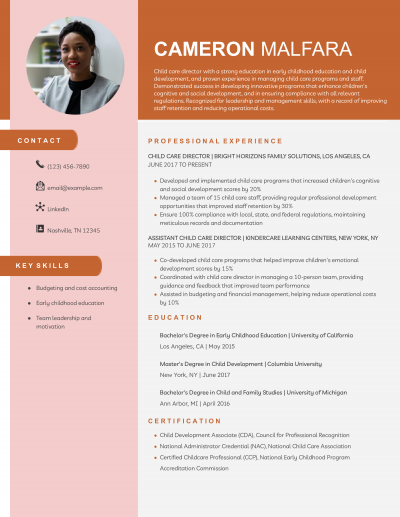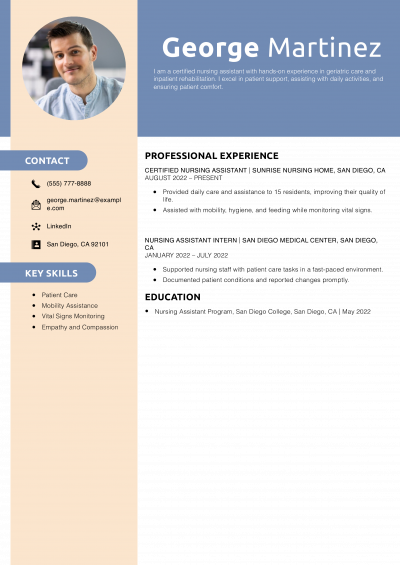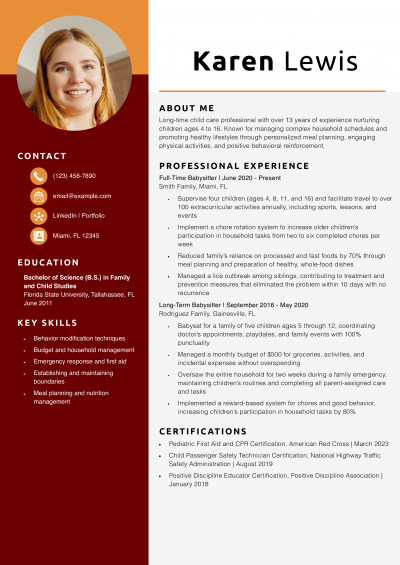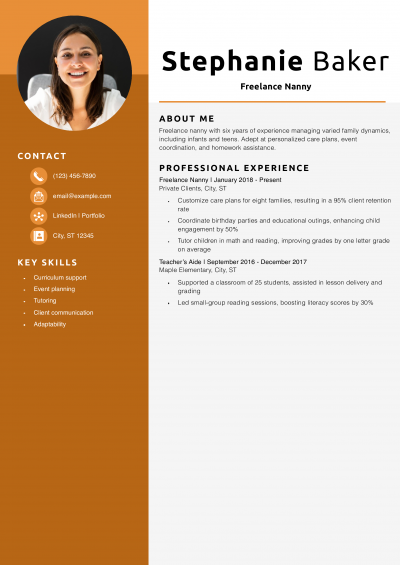As a caregiver, you do the important work of meeting the personal, emotional, and health care needs of your clients. Your caregiver resume should demonstrate this ability and prove to hiring managers you can act as a trusted advocate. This guide will teach you how to write an effective resume highlighting your capacity to care for the recovering, elderly, and disabled.
Key Takeaways
- Emphasize specializations: Caregivers can encompass a lot of different jobs from home health aide to day care assistant to pet care. Make sure your resume emphasizes which populations you have experience with, and if you’ve provided any specialized care such as for special needs people or dementia care.
- Detail quantifiable achievements: Providing care is mostly about compassion and service to others, but if there is a way to quantify your past job performance, go for it. For instance, how many people did you care for, did you receive high patient satisfaction ratings, or how many people did you help train?
- Use keywords for ATS: Applicant tracking systems (ATS) are sometimes used to screen resumes by searching for keywords and phrases related to the job posting. Look over job descriptions carefully and try to add some of the keywords mentioned where appropriate.
Most Popular Caregiver Resumes
Home Health Aide Resume Example
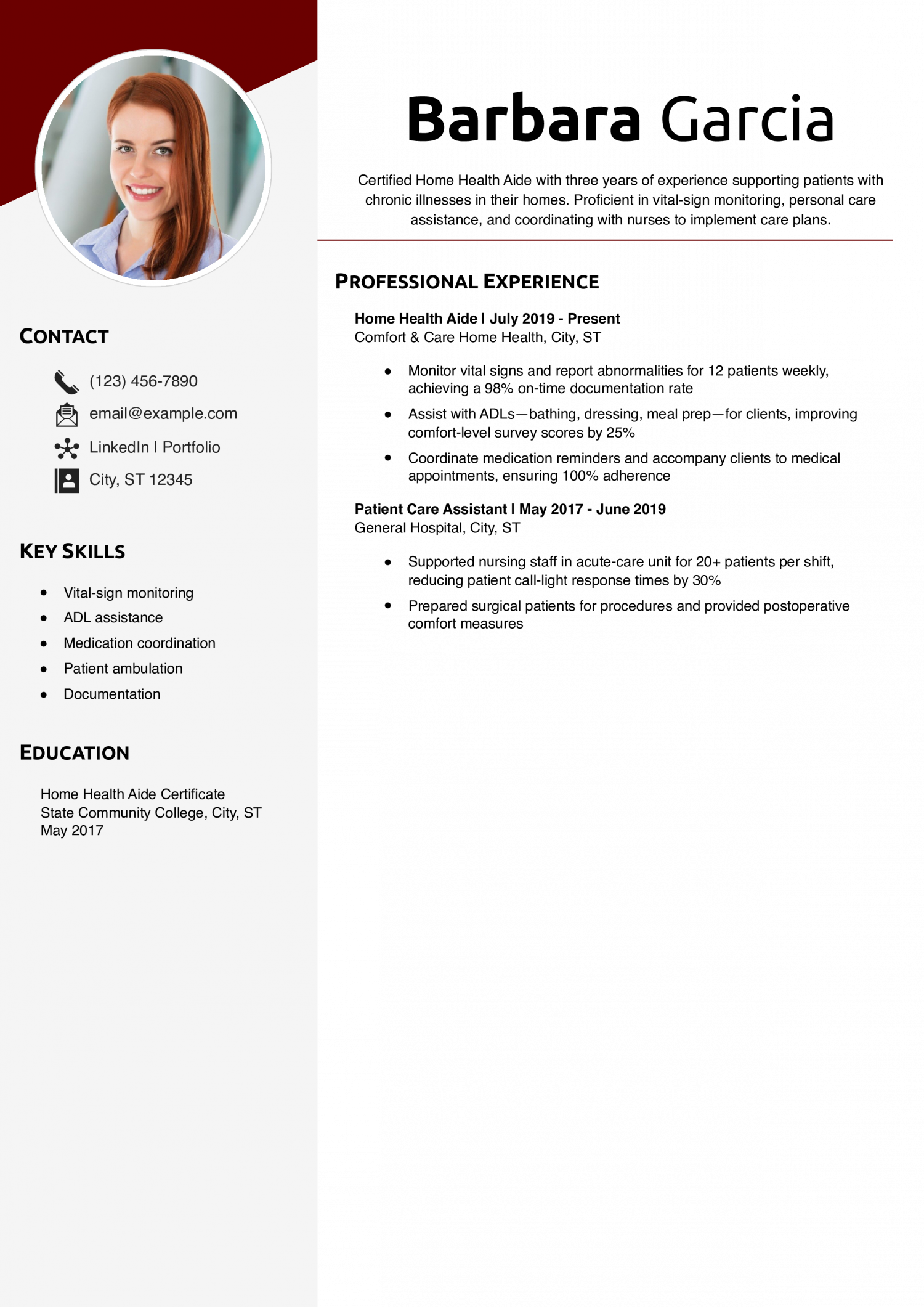
Why This Resume Is a Great Example
This resume directly links patient-satisfaction metrics and documentation accuracy to HHA responsibilities, illustrating both technical competence and compassionate care.
Key Tips
Quantify your compliance and survey-score improvements to demonstrate impact. For guidance on crafting effective objectives, see Resume Objective Examples.
Live-In Caregiver Resume Example
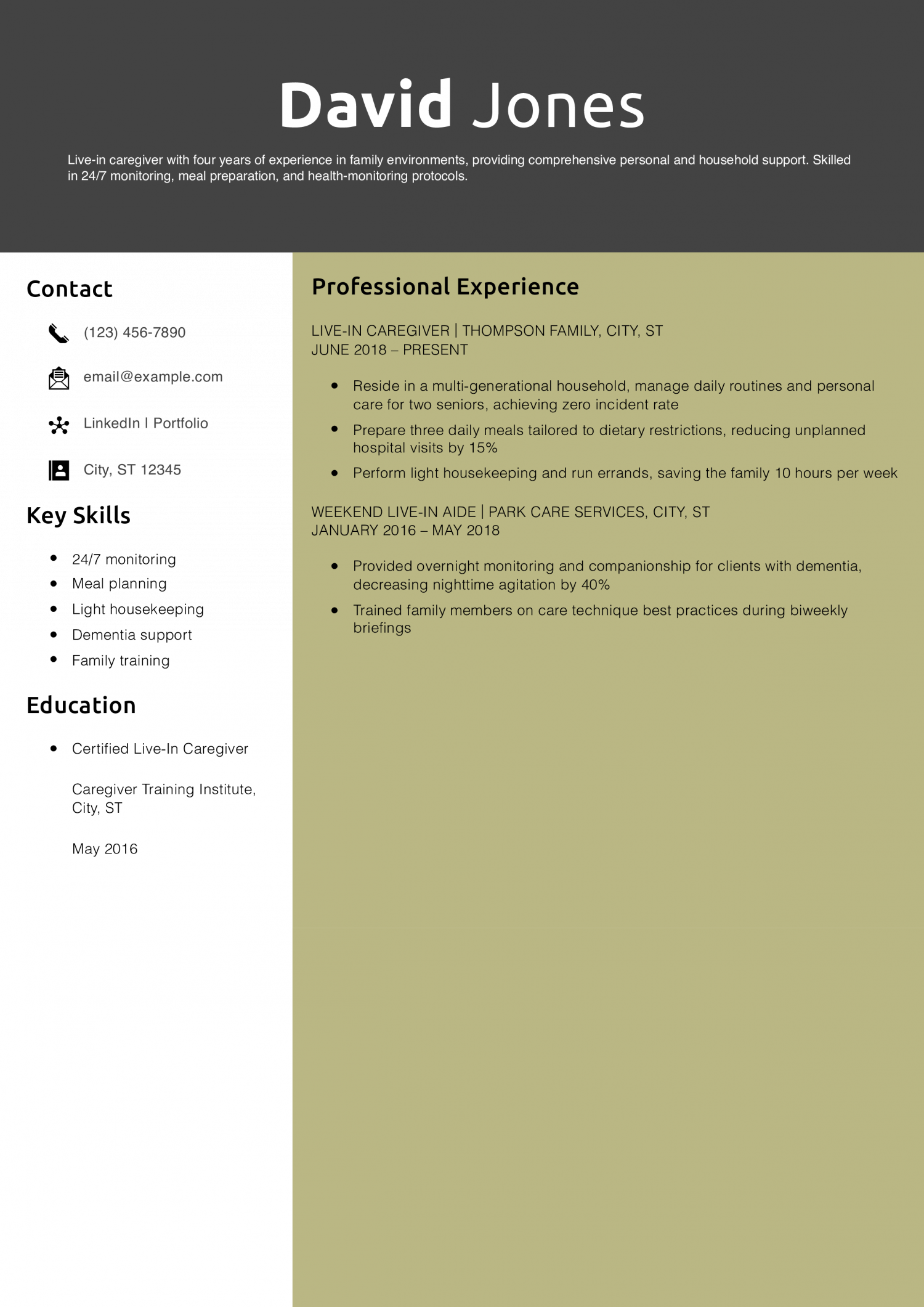
Why This Resume Is a Great Example
By tying zero-incident safety records and reduced hospital visits to live-in duties, this resume demonstrates both reliability and health-focused expertise.
Key Tips
Highlight your continuous-support metrics and family-training successes. For advice on format and layout, see Best Resume Formats.
Pediatric Caregiver Resume Example
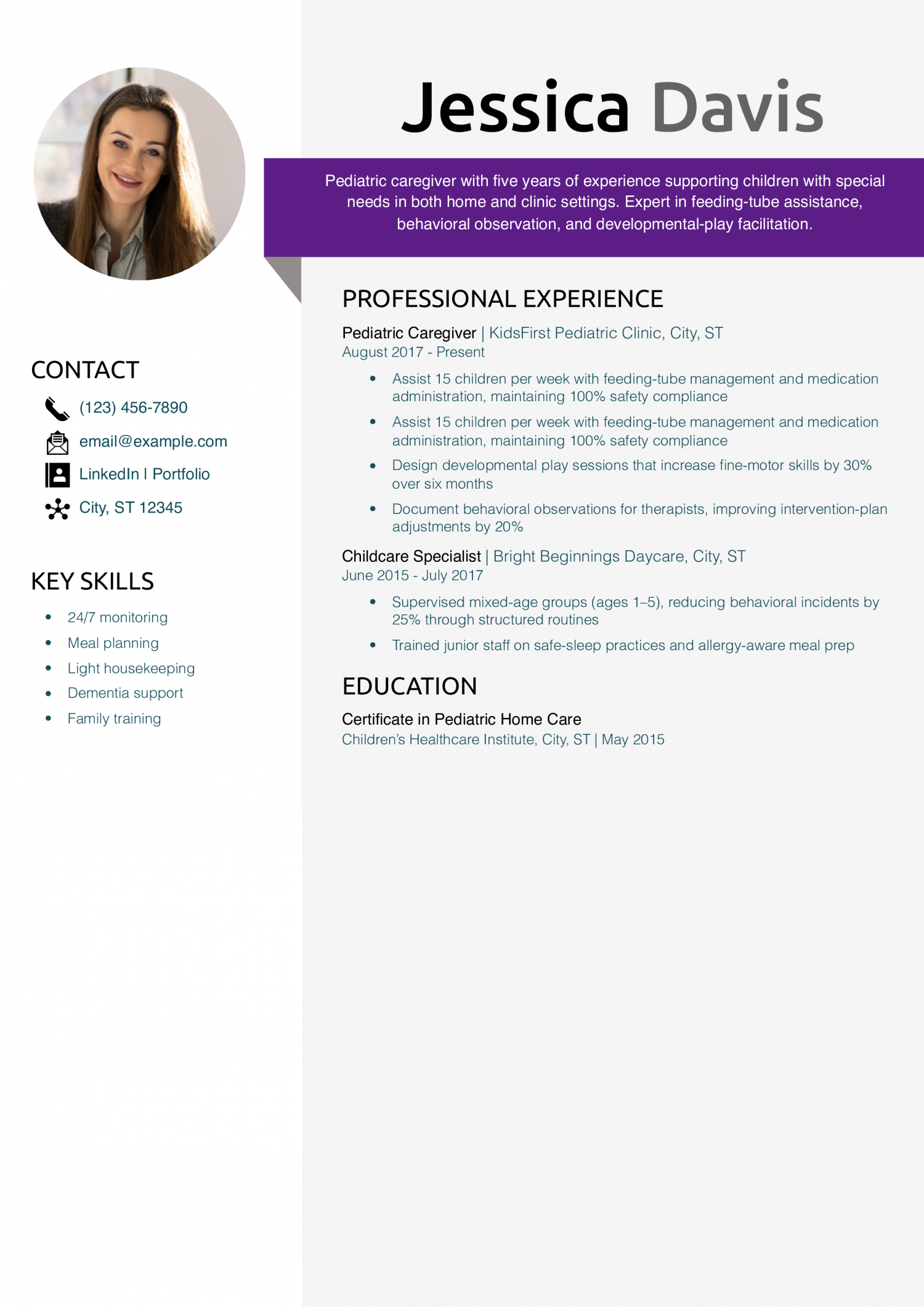
Why This Resume Is a Great Example
This resume directly connects skillful feeding-tube and developmental-play metrics to pediatric-care outcomes, showcasing both clinical and creative caregiving strengths.
Key Tips
Quantify your safety and developmental-improvement metrics. For tips on listing volunteer work, see How to List Volunteer Work Experience on a Resume.
Elderly Caregiver Resume Example
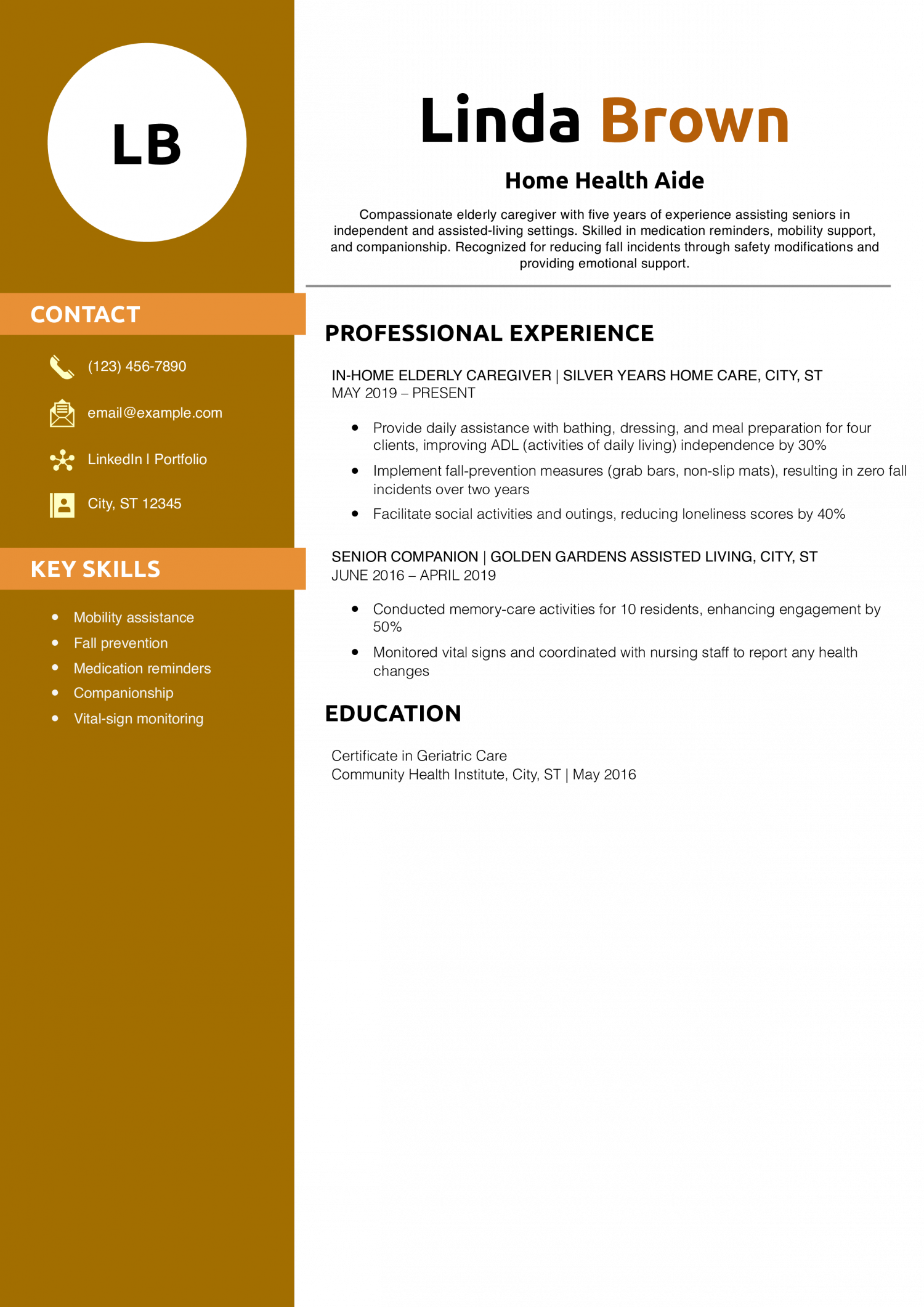
Why This Resume Is a Great Example
This resume ties fall-prevention and engagement metrics directly to improved senior well-being, demonstrating both safety expertise and compassionate companionship.
Key Tips
Highlight quantifiable safety and engagement improvements to showcase impact. For advice on structuring resumes, see Best Resume Formats.
In-Home Caregiver Resume Example

Why This Resume Is a Great Example
This resume links satisfaction and mobility metrics to personalized in-home care, showing both hands-on skills and teamwork with health professionals.
Key Tips
Emphasize collaboration with therapists and positive client feedback. For tips on listing skills, see Skills to Put on Resume.
Personal Caregiver Resume Example
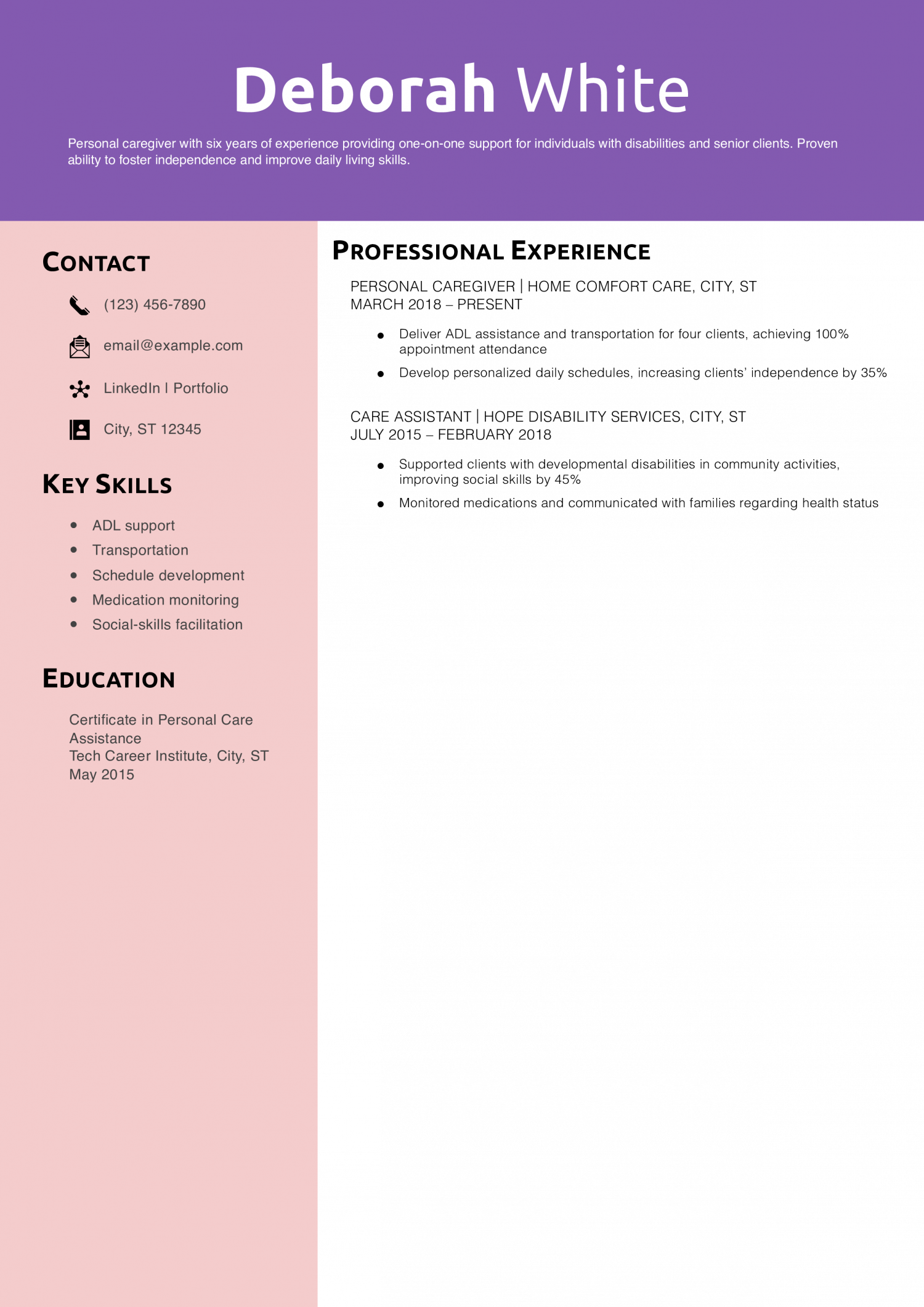
Why This Resume Is a Great Example
This resume quantifies appointment attendance and independence gains, demonstrating structured and empathetic personal care.
Key Tips
Highlight metrics around independence and reliability. For the best volunteer listings, see How to List Volunteer Work Experience on a Resume.
Animal Caregiver Resume Example
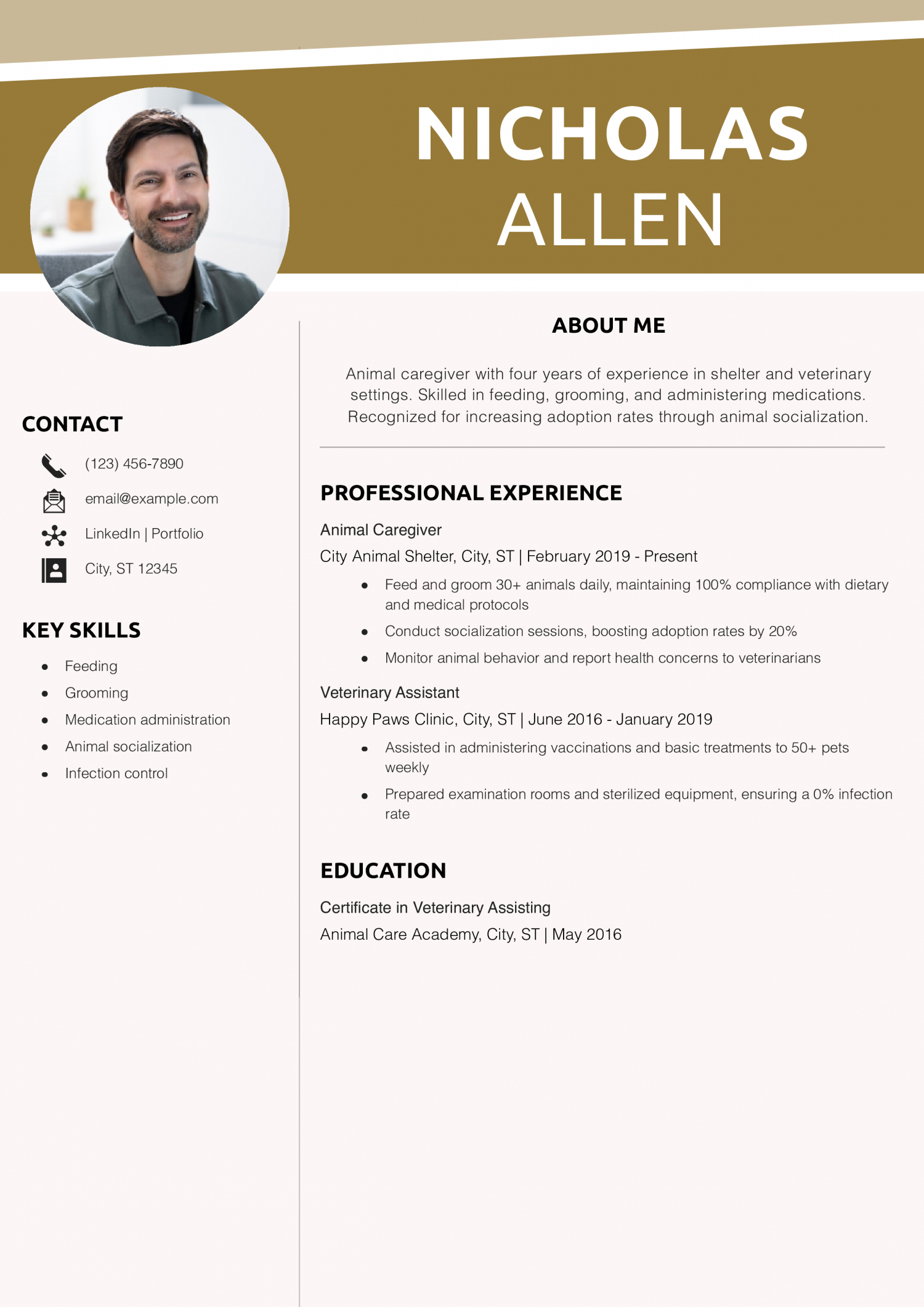
Why This Resume Is a Great Example
This resume ties adoption-rate improvements and infection-control metrics to animal-care expertise, demonstrating both hands-on skills and program impact.
Key Tips
Quantify adoption gains and compliance metrics to highlight effectiveness. For guidance on listing education, see How to List Education on a Resume.
Alzheimer’s Caregiver Resume Example
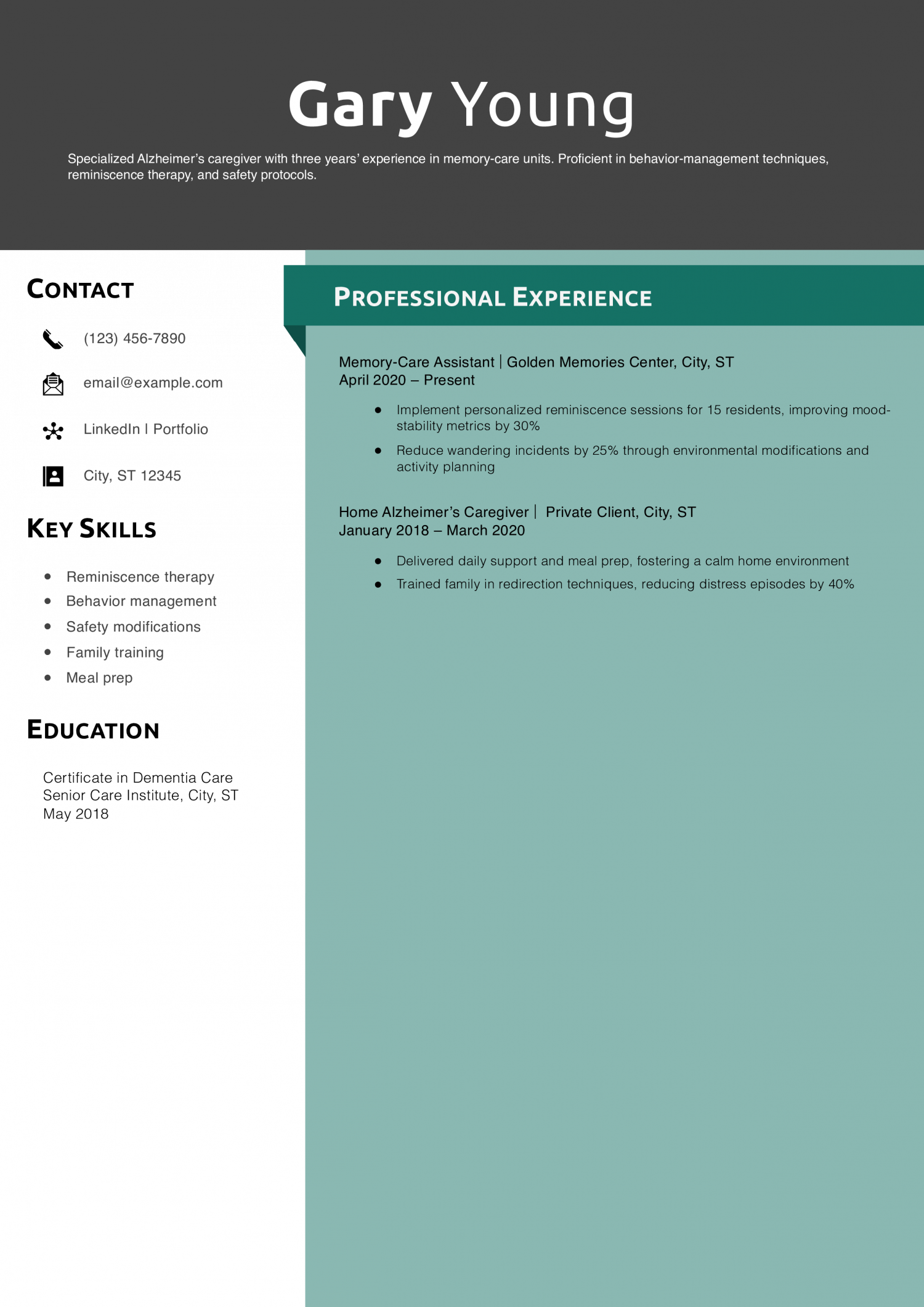
Why This Resume Is a Great Example
This resume connects mood-stability and incident-reduction metrics to tailored Alzheimer’s care techniques, showing both clinical and compassionate strengths.
Key Tips
Highlight behavior-management and safety-outcome metrics. For timeline guidance, see How Far Should a Resume Go.
Autism Caregiver Resume Example
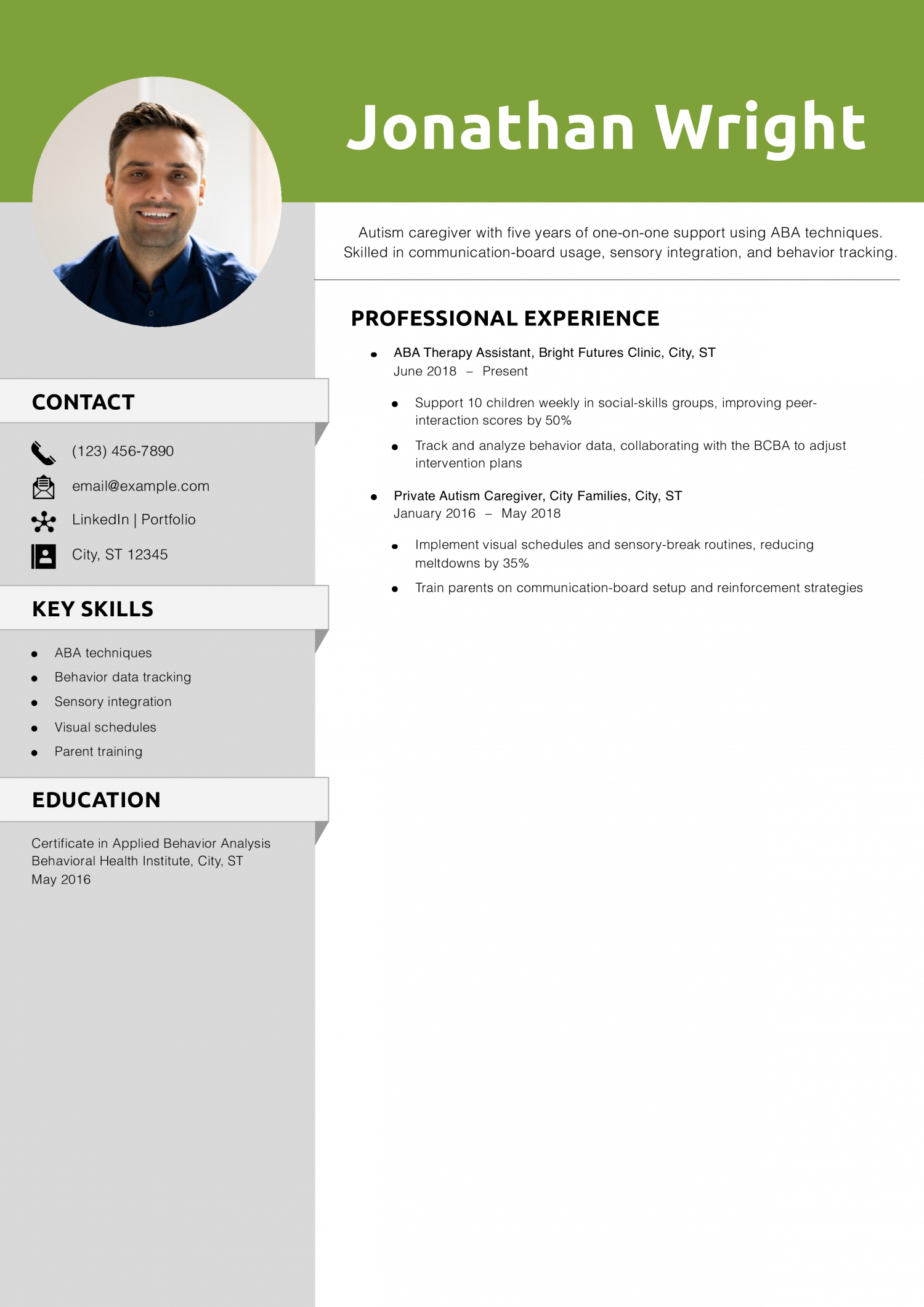
Why This Resume Is a Great Example
This resume ties social-skill improvements and meltdown-reduction metrics to ABA-based interventions, illustrating both data-driven and empathetic care.
Key Tips
Quantify behavior-change outcomes to showcase effectiveness. For technical skill ideas, see Hard Skills for a Resume.
Caregiver Resume Example Without Experience

Why This Resume Is a Great Example
This resume leverages volunteer and tutoring metrics to demonstrate transferable care and mentoring skills, showing readiness to enter the field.
Key Tips
Emphasize transferable volunteer achievements and training certifications. For tips on no-experience resumes, see How to Write a Resume With No Experience.
CNA Caregiver Resume Example

Why This Resume Is a Great Example
This resume links fall-reduction and charting-accuracy metrics to CNA responsibilities, highlighting both technical skills and patient safety.
Key Tips
Quantify fall-reduction and accuracy improvements to emphasize clinical impact. For credential listing, see How to List a GED on a Resume.
Companion Caregiver Resume Example
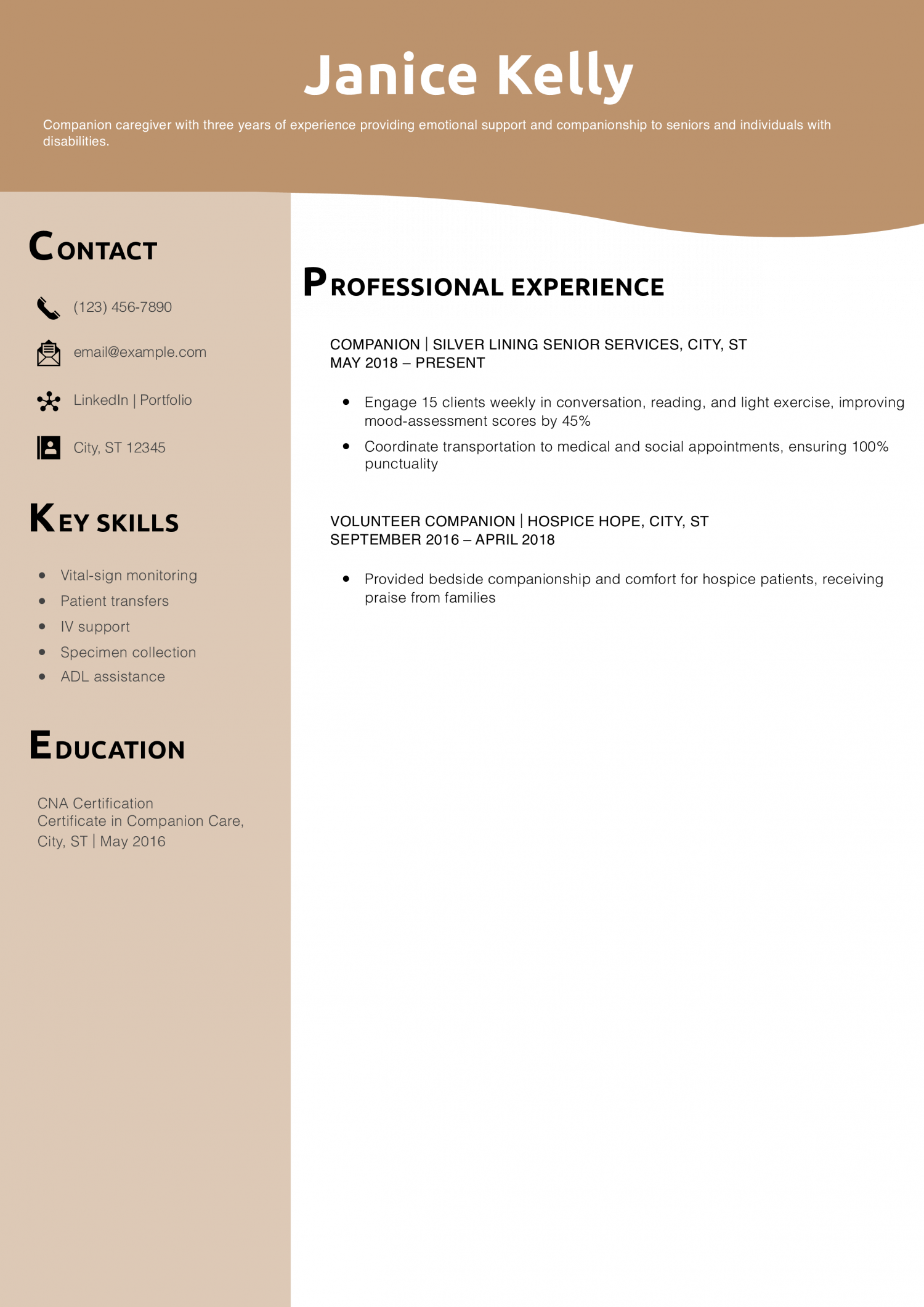
Why This Resume Is a Great Example
This resume quantifies mood-improvement and punctuality metrics, showcasing compassionate companionship and reliability.
Key Tips
Highlight assessment-score improvements and punctuality to show your reliability. For formatting advice, see Best-Looking Resumes.
Hospice Caregiver Resume Example
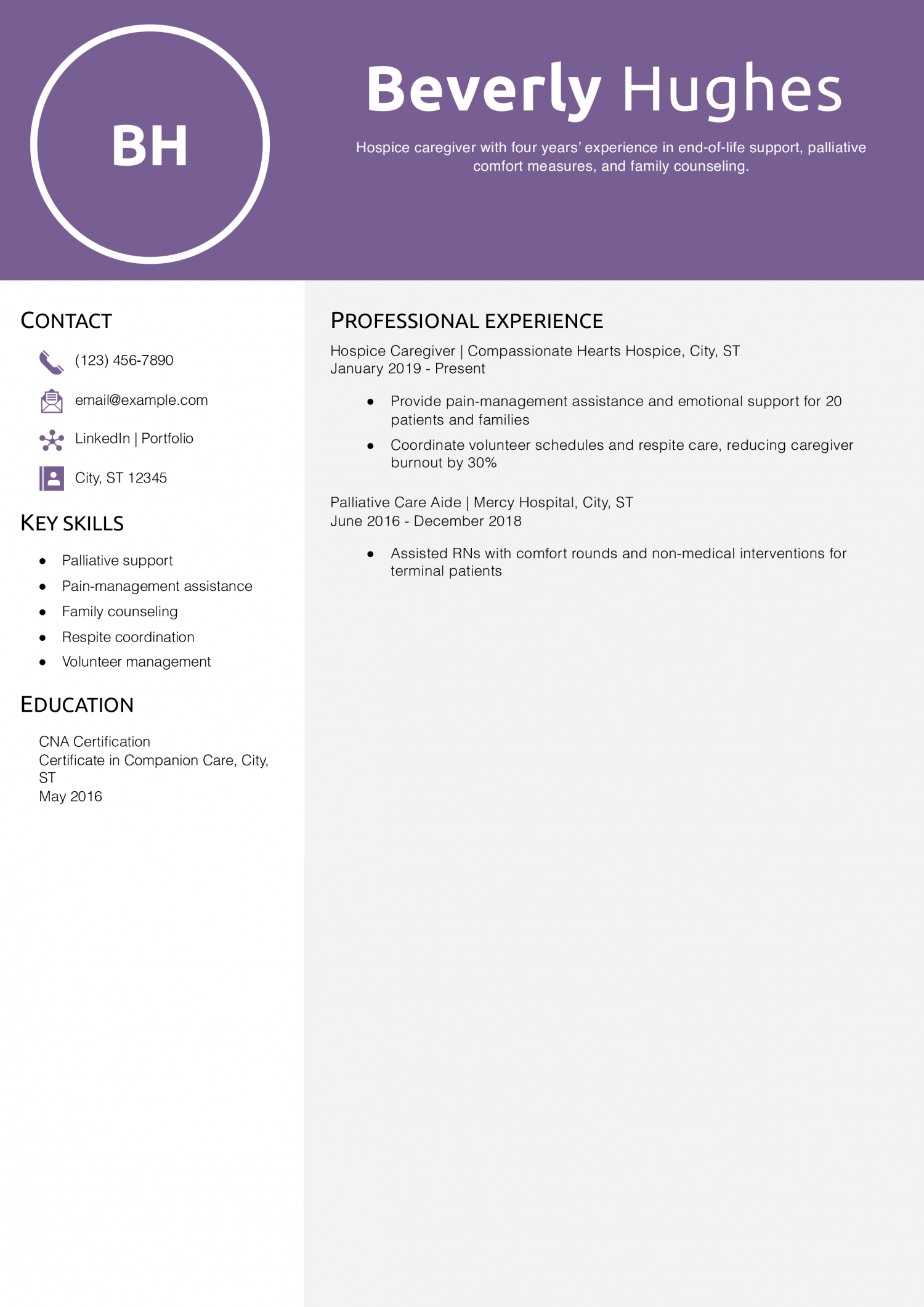
Why This Resume Is a Great Example
This resume ties burnout-reduction and patient-support metrics to hospice care roles, demonstrating both clinical empathy and program coordination.
Key Tips
Quantify respite-care and burnout metrics to highlight your program-level impact. For objective examples, see Resume Objective Examples.
Physical Disability Caregiver Resume Example
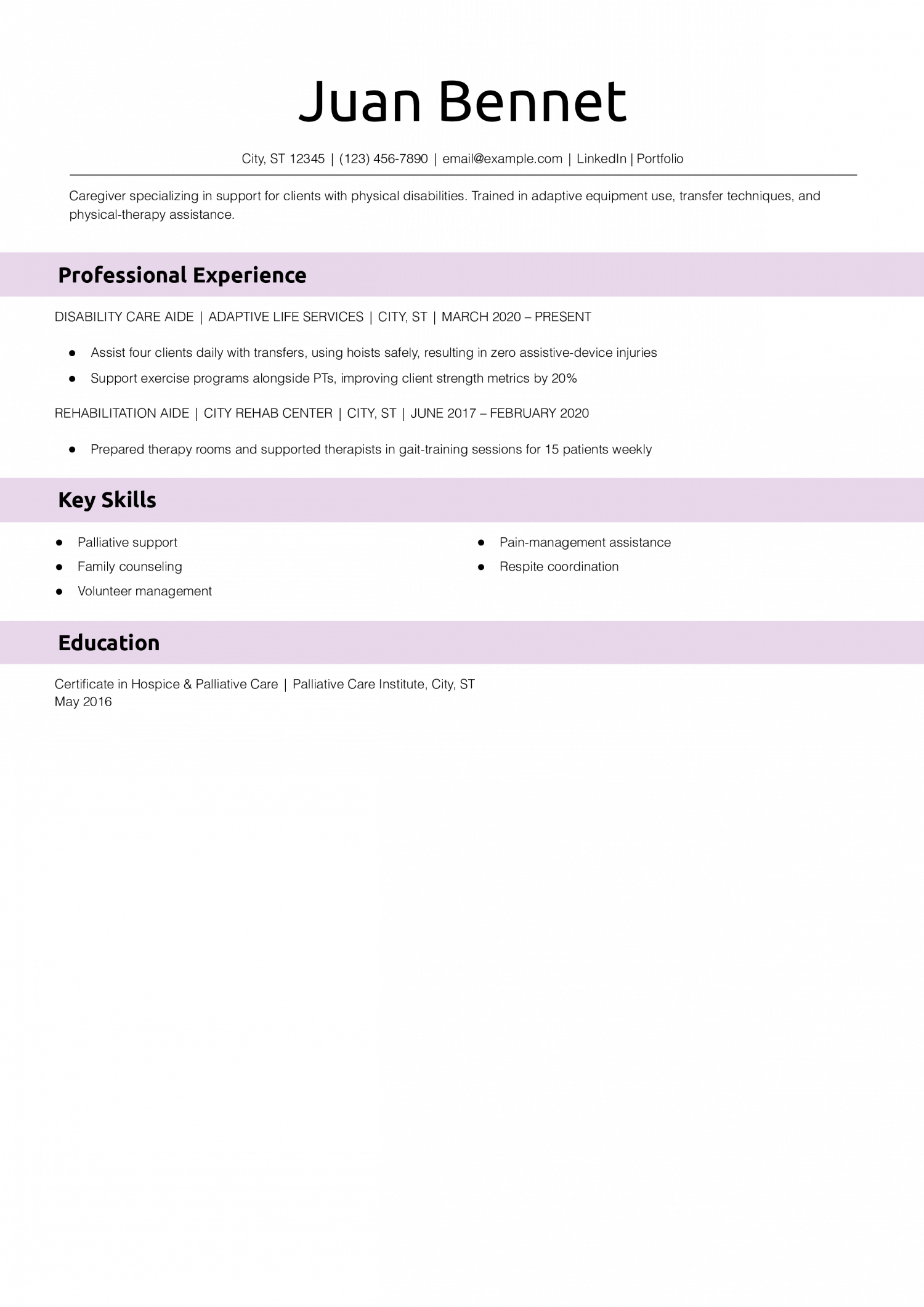
Why This Resume Is a Great Example
This resume highlights a zero-injury record and strength-improvement metrics, demonstrating both safety expertise and therapy support impact.
Key Tips
Emphasize your safety record and strength-gain results. For tips on formatting education, see How to List Degree on Resume.
Alzheimer’s Caregiver Assistant Resume Example
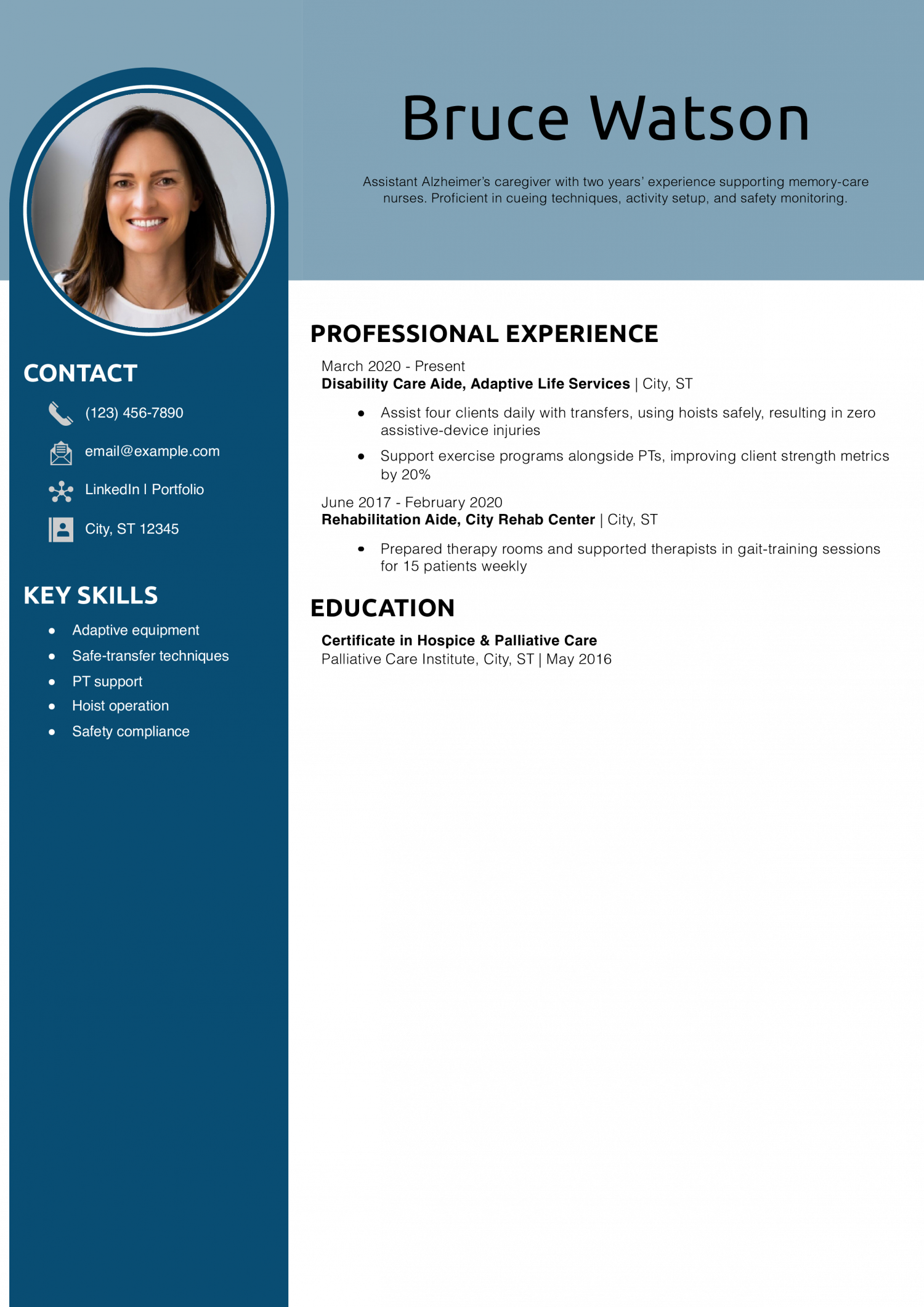
Why This Resume Is a Great Example
This resume ties orientation and safety metrics to assistant-caregiver duties, demonstrating both cognitive support and vigilance.
Key Tips
Quantify orientation and safety improvements to showcase your support role. For tips on career updates, see How to Update Your Resume.
Companion Dementia Caregiver Resume Example

Why This Resume Is a Great Example
This resume connects mood and agitation metrics to validation and reminiscence care, showcasing therapeutic and supportive strengths.
Key Tips
Highlight mood-improvement and agitation-reduction metrics to demonstrate therapeutic impact. For skill-listing guidance, see Transferable Skills Resume.
Hospice Companion Resume Example

Why This Resume Is a Great Example
This resume ties satisfaction and support-gap metrics to companion roles, demonstrating both emotional and organizational impact.
Key Tips
Emphasize emotional-support metrics and coordination successes. For formatting headers, see What Is a Good Headline for a Resume.
Respite Caregiver Resume Example

Why This Resume Is a Great Example
This resume highlights positive feedback and reliability metrics, showing your effectiveness in respite roles.
Key Tips
Highlight client feedback scores to showcase trustworthiness. For tips on career-advice phrasing, see Career Advice: How to List Administrative Skills on Resume.
Autism Support Caregiver Resume Example
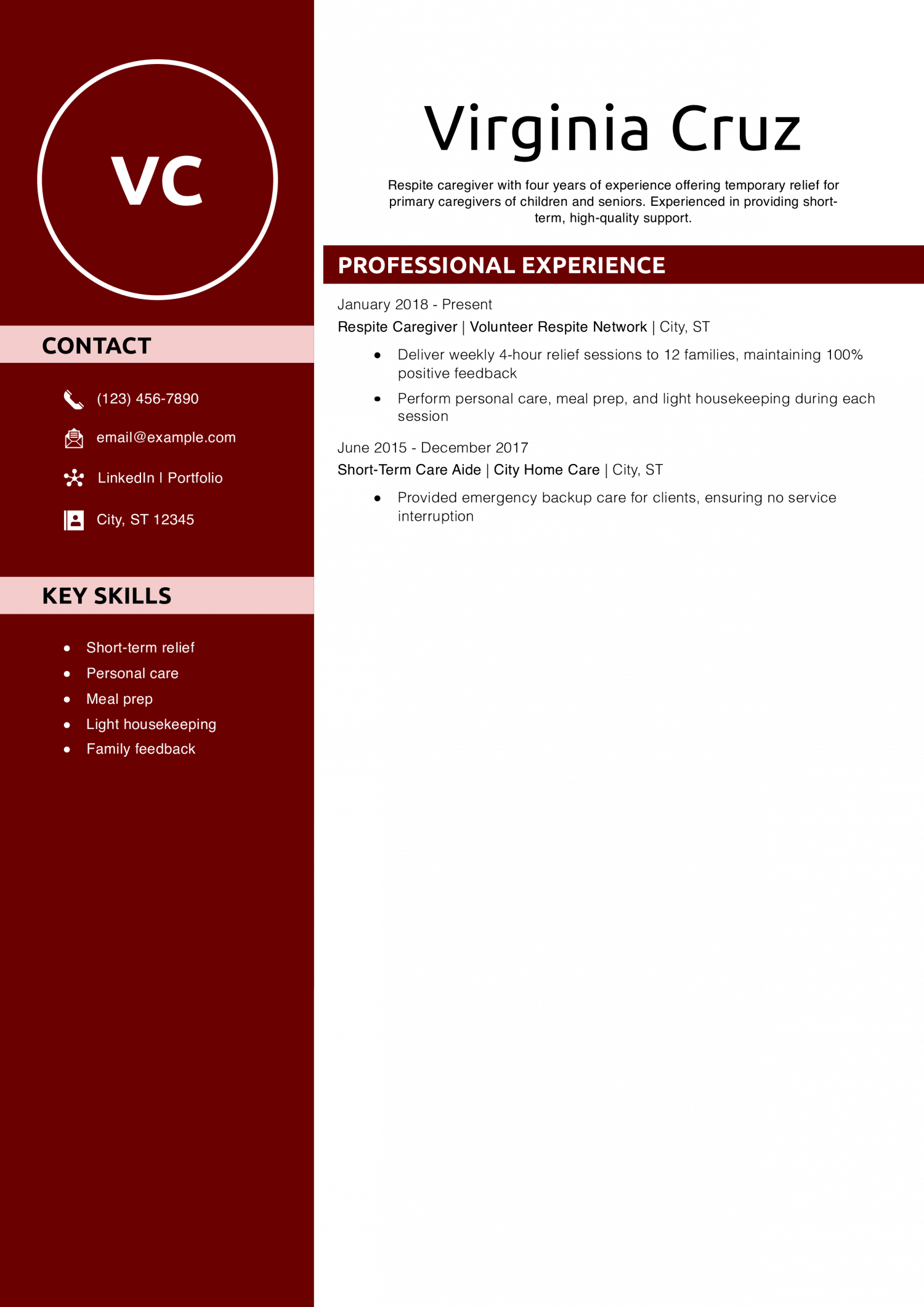
Why This Resume Is a Great Example
This resume quantifies communication and consistency improvements, demonstrating both technical and training capabilities.
Key Tips
Emphasize data-driven outcomes and family-training metrics to highlight your expertise. For insights on volunteer work, see How to List Volunteer Work Experience on a Resume.
Companion Hospice Caregiver Resume Example

Why This Resume Is a Great Example
This resume ties communication-score and medication-adherence metrics to companion roles, showcasing your direct impact on patient well-being.
Key Tips
Quantify improvements in communication and adherence to highlight your value. For resume-building tips, see How to Make a Resume.
Caregiver Text-Only Resume Examples and Templates
How To Write a Caregiver Resume Example
When writing your resume, use a professional template to ensure you cover all the major aspects of your health care career. A strong caregiver resume will include these sections:
- Contact information
- Profile
- Key skills
- Professional experience
- Education and certifications
Below is a step-by-step guide for putting together a resume, along with caregiver resume examples.
1. Share your contact information
At the top of the page, provide your full name, phone number, email address, location, and a link to your online professional profile. Check your contact information for errors before submitting your caregiver resume to make sure potential clients and hiring managers can reach you for an interview.
Example
Your Name
(123) 456-7890
[email protected]
City, State Abbreviation Zip Code
LinkedIn | Portfolio
2. Craft an outstanding profile with a summary of your caregiver qualifications
Introduce yourself and draw in the reader with a brief, compelling resume profile. In a few sentences, mention your job title, years of experience, and a few strengths or specializations. Prove that you’re qualified to work in their home or facility setting by highlighting those qualities the hiring manager is looking for, and include a few keywords from the job ad.
Senior-Level Profile Example
Extensive academic background in nursing and gerontology, coupled with practical experience in senior caregiving, offering specialized and highly skilled caregiving services. Proven strengths include developing and executing individualized care plans, managing teams, ensuring high-quality patient care, and acting as a primary liaison between healthcare teams and families. Additional qualifications include certification in senior first aid and CPR, proficiency with care management software, specialty care training, as well as certifications from reputed healthcare institutions such as the State Nursing Board and American Caregiver Association.
Entry-Level Profile Example
An enthusiastic and dedicated professional with academic backgrounds in nursing and psychology combined with certifications in patient care. Experience in providing personal assistance, preparing meals, performing basic healthcare services, and working closely with healthcare providers. Demonstrated success in childcare and pet care, coupled with excellent communication skills, further highlights dedication to providing exemplary care, whether in healthcare settings or residential environments.
3. Showcase your caregiver experience
When describing your work history, list what you did in each role, but think of them as more than just tasks. Describe the daily activities you managed, how you cared for clients, and the emotional support you provided. Show the depth of your role and how you made a difference in the lives of your clients. Where possible, use numbers to give value to your accomplishments.
Senior-Level Professional Experience Example
Senior Caregiver, Sunrise Senior Living, New Haven, CT | June 2017 – Present
- Developed and executed comprehensive care plans for over 50 seniors, making necessary adjustments based on assessment of patients’ condition and needs
- Supervised a team of 5 other caregivers, managing their scheduling, training them in caregiving best practices, and ensuring optimal care for all patients served by the team
- Served as primary liaison between patients, families, and healthcare teams, attending over 150 medical appointments to communicate health updates and educating families for better support
Junior Caregiver, Learning Care Group, Fairfield, CT | June 2014 – May 2017
- Provided advanced care to over 30 elderly patients, including those with dementia or physical disabilities
- Became certified in senior first aid and CPR, providing emergency health interventions when needed
- Gained extensive experience with care management software, improving patient record redundancy and efficiency by 35%
- Actively participated in specialty care training programs
Entry-Level Professional Experience Example
Childcare Assistant, Bright Horizons, Baltimore, MD | March 2021 – Present
- Assisting in the daily care and supervision of children ranging from newborns to five years of age
- Developing and implementing educational activities that contribute to a child’s physical, emotional, and social growth
- Successfully applying for and receiving a grant that allowed for the purchase of new, developmentally appropriate toys and learning materials for the facility
Pet Care Specialist, PetSmart, Baltimore, MD | August 2020 – February 2021
- Actively participated in the daily care of diverse pets including dogs, cats, small animals, reptiles, and fish
- Effectively communicated and educated customers on basic pet care and nutritional needs
- Recognized for going above and beyond in job duties by achieving a 10% increase in overall pet adoption rates within first six months of employment
Resume writer’s tip: Quantify your experience
Numbers provide a tangible way for employers to see your impact as a caregiver. So, think about moments in previous roles that you could measure with numerical values. How many clients did you care for? Did you improve a process by a certain percentage? Demonstrate the positive, quantifiable difference made in the lives of your clients.
Do
- “Gained extensive experience with care management software, improving patient record redundancy and efficiency by 35%”
Don’t
- “Worked with care management software”
Resume writer’s tip: Tailor your resume for each application
Although the demand for home health and personal care aides is projected to increase at a much faster than average rate, competition will be tough for the best jobs. Just like you tailor your approach to each client, you must adjust your resume for each job application.
Pay attention to the specific words and phrases used in the job listing. For example, if they talk about “client support,” use that phrase in your resume. This strategy shows that you’ve put thought into your application and that you understand what this specific role entails.
What if you don’t have experience?
You may be new to the field, but your resume can still prove you have what it takes to be a great caregiver. Instead of detailing a long work history, focus on your relevant education and training. List pertinent degrees, coursework, and workshops to demonstrate that you have a foundation of knowledge to draw on.
Think of the skills you’ve gained from other areas of your life relevant to caregiving. Volunteering at a nursing home, caring for a family member, and working in customer service are all experiences that teach critical skills like compassion, patience, and effective communication.
4. Outline your education and caregiver-related certifications
Whether it’s a high school diploma or a college degree, list your highest level of education. In addition to your academic background, include any relevant certifications and licenses. If you’re a CNA, hiring managers should know. Are you certified in Basic Life Support (BLS), CPR, first aid, or other specializations? List those on your resume as well.
Education
Template:
[Degree Name]
[School Name], [City, State Abbreviation] | [Graduation Year]
Example:
Associate of Science in Nursing
University of Maryland, Baltimore, MD | May 2020
Certifications
Template:
[Certification Name], [Awarding Organization], [Completion Year]
Example:
- Home Health Aide Certification (HHA) – National Association for Home Care & Hospice, 2021
5. List key caregiver skills and proficiencies
In caregiving, every client is unique, and so is every job. To show hiring managers you have the specific caregiver skills they’re looking for, create a list of abilities that align with those required of the job. For example, if they need someone with experience in Alzheimer’s support, be sure to mention skills you have related to caring for dementia clients.
Some examples of caregiver keywords include:
| Key Skills and Proficiencies | |
|---|---|
| Alzheimer’s and dementia care | Basic life support (BLS) |
| Emotional intelligence | Medication administration |
| Mobility assistance | Nutritional planning and preparation |
| Vitals monitoring | |
Resume writer’s tip: Use specific action verbs
Using action verbs in your resume helps to bring your daily caregiving activities to life. Instead of just saying you were responsible for a task, these dynamic words illustrate your work in action. So, start each bullet point in your professional experience section with a verb to show how you interacted with and cared for your clients. Use the words below to liven up your caregiver resume:
| Action Verbs | |
|---|---|
| Administered | Assisted |
| Coordinated | Demonstrated |
| Encouraged | Guided |
| Implemented | Monitored |
| Nurtured | Organized |
| Provided | Recorded |
| Supported | Trained |
| Transported | |
How To Pick the Best Caregiver Resume Template
When selecting your caregiver resume template, the emphasis should be on your qualifications and accomplishments rather than aesthetics or design elements. In other words, opting for a clean, simple template that is easy to scan and ATS-friendly is the best approach.
Frequently Asked Questions: Caregiver Resume Examples and Advice
The job outlook for caregivers is expected to grow much faster than the average occupation through 2032, according to the Bureau of Labor Statistics. Even with lots of job openings available, tailoring your resume for each job can help you target more competitive offers. Look closely at job postings to see what the employers are seeking, and think about which of your skills align best. Then, swap in or emphasize those matching skills on your resume so that it aligns with the specific needs of each hiring manager.
A Caregiver resume example serves as a great starting point to format and structure your resume. Look at how the professional experience is outlined, how skills are listed, and the overall flow of information. Use these examples to inspire your own resume, but make sure to adjust the content to reflect your unique accomplishments and the specific role you're applying for.
As with the majority of careers, choosing a chronological resume is usually best for caregivers. As the most common format, recruiters will know what to look for and how to scan your resume to determine if you are a strong candidate match.
Include a cover letter with your resume
Including a cover letter with your resume gives you another opportunity to make a strong impression with the recruiter. Speak directly to the recruiter by writing a cover letter that highlights your accomplishments and expresses your interest in the position.
Check Out Related Examples
Resume Templates offers HR approved resume templates to help you create a professional resume in minutes. Choose from several template options and even pre-populate a resume from your profile.

